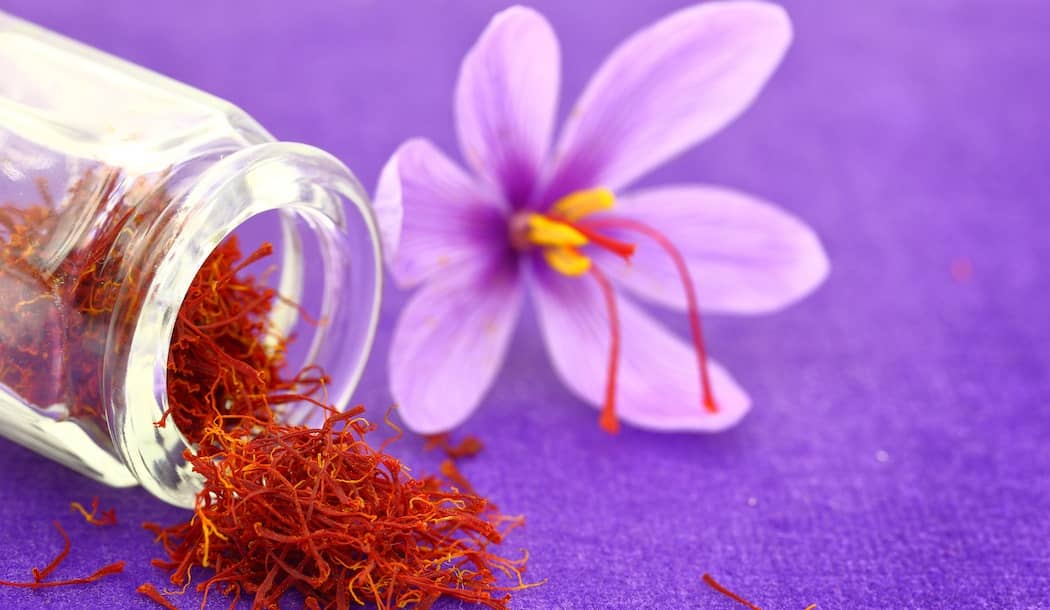
In temperate regions, the lovely purple, lilac or white flowers of the crocus bulb are one of the most welcome sights of the year, being pretty much the very first sign of spring.
The edible part comes from the bright red-orange stigmas found in the center of each flower. This is where saffron spice is harvested and used around the world in breads, desserts, and even main dishes.
Saffron isn’t easy to come by, which is why it has become the world’s most expensive spice. And now, the latest research into its cancer-fighting properties suggests saffron might be worth every penny.
Saffron is one of the more prominent flavors in an Indian curry or Spanish paella, and it seasons additional dishes commonly found in the Mediterranean, the Middle East, Scandinavia, and England.1
Saffron is rich in flavor and in price. One pound of saffron can cost upwards of $2,000!2 Contrast that with turmeric spice, which is the most common cooking substitute for saffron, and which sells at an average of 38 cents to $1.11 an ounce. Fortunately for us cooks saffron is very strong and most recipes call for just a bit.
Saffron is expensive because the tiny floral stigmas needed to make the spice are harvested by hand using tools that resemble tweezers. It takes as many as 75,000 saffron blossoms—all hand harvested— to produce just one pound of saffron spice.3 And I’d hate to be the guy who has to plant the 30 or 40 thousand bulbs required. But the flavor of saffron is worth the effort and the cost, and so are its healing properties.
Ancient herbal remedy
Saffron has a long history of medicinal use. In fact, saffron was used as an herbal remedy for a host of ailments by the ancient Arabian, Indian, and Chinese cultures.4 And during the European Middle Ages, saffron was introduced to Spain by Arabic people. From there it spread throughout Western Europe as a dye and a delicacy, but also, most prominently, as a mood enhancer.5
Those healing properties are believed to stem from the many antioxidants found in saffron, which include kaempferol, safranal, crocin and crocetin.
Crocin and crocetin are the two antioxidant carotenoids responsible for the deep yellow-orange color of saffron, and both may have antidepressant properties. They’re also believed to help reduce appetite, limit inflammation, protect brain cells and, especially in the case of crocetin, even fight cancer.6
Anti-tumor agent works in four ways
Crocetin has shown significant potential as an anti-tumor agent in various animal models and cell culture systems, thanks to a unique ability to halt the growth of cancer cells. Crocetin appears to work against cancer in four important ways:
- Inhibits the synthesis of nucleic acid that’s necessary for the growth of cancer cells.
- Improves anti-oxidative systems.
- Kills cancer cells by inducing apoptosis (cell suicide).
- Stops the signals required for cancer to grow and spread.7
There’s evidence of these actions of crocetin, and saffron in general, within more than 150 scholarly articles written about the spice’s effect on cancer. In virtually all the published papers, saffron and its carotenoids stop cancer from growing and spreading.8
One of the most notable studies is about the effect of crocetin on esophageal cancer when combined with a chemotherapy drug called cisplatin. In the study, researchers treated cancer cells singularly with crocetin or cisplatin, or a combination of both.
Interestingly, it was the combined effect of the natural crocetin with the drug cisplatin that resulted in the most significant levels of cell apoptosis and lowered cell proliferation, suggesting the two have an excellent synergistic effect.9
This bodes well for the future of esophageal cancer, which has the highest incidence rate worldwide and tragically often surfaces only in the advanced stages, usually meaning a poor prognosis for patients.
Chemotherapy with cisplatin is often the go-to treatment, but it has a terrible toxicity effect and side effect rate. Combining cisplatin with a plant-based treatment that improves efficacy and reduces toxicity could have a great influence on overall treatment outcome.10
Also helps mood and memory, and
balances hormones
The most common medicinal uses for saffron today are to improve mood, boost libido, and enhance memory.11 The spice is also touted for its role in alleviating premenstrual syndrome.12
Many of these additional health benefits come from other compounds within saffron. For example, safranal is the origin of saffron's distinct taste and aroma. Studies suggest that this rich compound boosts mood, improves memory and learning ability, as well as fights oxidative stress.
Meanwhile another compound in saffron, called kaempferol, helps reduce inflammation and depressive activity while also providing some anti-cancer properties.13
Grow your own at minimal cost
If you want to produce your own saffron from home, you won’t need a lot of space. The stems of the crocus plant only reach three to six inches in height, making it one of the most compact garden bulbs you can plant.
About two-dozen saffron crocus plants should supply you with enough of the coveted spice in their first year to season at least a few memorable dishes. Every year after that, the plants will multiply and you’ll be able to harvest more of the spicy stigmas.14 The only catch is that crocus bulbs require a cold winter while they’re dormant. To grow them inside, you can work around this by refrigerating them for a while – I’ll leave it you to look up the details.
Along with consuming saffron as a flavor in your food, you can also buy it online in capsules, which are generally broken up into servings of 100 mg or less.
It should be noted that, like many other herbs and spices, overconsumption can lead to illness and even death. The World Health Organization (WHO) states that eating 20 grams of saffron in a day (the better part of an ounce), can be fatal.15 But that’s a heck of a lot so I’m going to assume good sense will protect you and others from that hazard.
Best regards,

Lee Euler,
Publisher
References:
- https://www.whiteflowerfarm.com/910891-product.html#!growguide
- https://www.everydayhealth.com/diet-nutrition/diet/saffron-pricing-origin-health-effects-recipes/
- https://www.webmd.com/vitamins/ai/ingredientmono-844/saffron
- https://www.ncbi.nlm.nih.gov/pmc/articles/PMC4461363/
- https://www.everydayhealth.com/diet-nutrition/diet/saffron-pricing-origin-health-effects-recipes/
- https://www.healthline.com/nutrition/saffron#TOC_TITLE_HDR_2
- https://www.ncbi.nlm.nih.gov/pmc/articles/PMC4461363/
- https://www.eurekaselect.com/168646/article
- https://cancerci.biomedcentral.com/articles/10.1186/s12935-017-0468-9
- https://cancerci.biomedcentral.com/articles/10.1186/s12935-017-0468-9
- https://www.healthline.com/nutrition/saffron#TOC_TITLE_HDR_2
- https://www.webmd.com/vitamins/ai/ingredientmono-844/saffron
- https://www.healthline.com/nutrition/saffron#TOC_TITLE_HDR_2
- https://www.whiteflowerfarm.com/910891-product.html#!growguide
- https://www.everydayhealth.com/diet-nutrition/diet/saffron-pricing-origin-health-effects-recipes/


